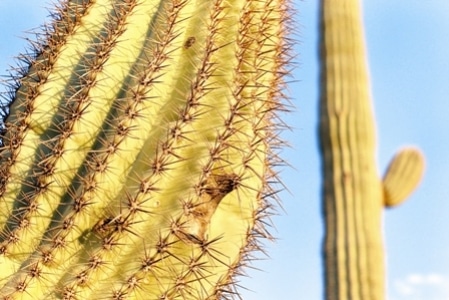Phuket Gardening: Plant life in the dry lane

PHUKET: Most Phuket gardeners probably don’t give growing catci a second thought. Here’s why they should…
Although Euphorbias are one of the largest genera of succulents, cacti (cactacea) are certainly the best known. There are plenty of them in Thailand, even though most of them come from the Americas.
Think of all those cowboy films with Mexican bandits and gun-toting outlaws, framed by a parched landscape of prickly pears. They are indeed abundant and much-loved in the Americas.
In common with our friend the crown of thorns, most cactacea are both succulent and spiny.
That is not to say they are normally edible, although both the dragon fruit and the prickly pear most certainly are. Succulents have stems, which store water. Most are also photosynthetic, which means they produce chlorophyll in the same way most leaved plants do.
Their waxy coating also means that they are very efficient at retaining water. If you cut a stem off it may well survive until the next rain-burst. The spines are another matter however. They are there mainly for protection against would-be predators in a harsh environment. They also provide a degree of shade and help increase the humidity around the plant.
Cacti are one of nature’s oddities, but make no mistake, they are perfectly adapted to life in the dry lane. Because most of them have thickened, often cylindrical bodies, their capacity for water absorption and retention is amazing. It has been calculated that a super-large cactus such as giganteae carnegiea, can soak up 3,000 liters of rainwater during a 10 day period. After all, that may be the only rain it gets for six months.
This ability means that most cacti enjoy long periods of dormancy, when they more-or-less hibernate. This is excellent news for the drought-prone garden, or for the dozy gardener who can’t be bothered watering.
Cacti vary enormously in size and shape. The largest can grow to 15 meters, though most are much smaller. Some are perfect for rockeries, or for small containers.
Many are cultivated and sold as house plants. There are two important considerations to
be made when growing cacti. Firstly, make sure that they have plenty of sand in their soil mix, since Cacti require a growing medium rich in minerals and too much organic matter will not be appreciated. Secondly, never over-water. If you do, your plant will almost certainly rot.
One cactus worth mentioning here is the wax rose (pereskia bleo), also known as kuu lab phuu kaam in Thai. It has the plant’s characteristic spines – and particularly nasty ones at that – but in some ways it is not a typical cactus because it has leaves, and assumes the form of an open and woody shrub. Moreover, its flowers are attractive and by no means inconspicuous. Bright orange in color, they resemble a single rose.
Glossy, green and conical seed heads are another distinctive feature. The wax rose will drop most of its pale green leaves at this time of year, but it is pretty tough. A vigorous grower, it can reach four meters in height. It prefers a sunny location, and like all members of the cactus clan, it does best in dryish soil. It won’t, however, tolerate bone-dry conditions for too long; its leaves will turn yellow and drop off. And if it gets too much water, the new growth will be top-heavy and brittle.
The rose cactus, or pereskia grandiflora, is from the same branch of the cactus family. It produces large clusters of pink flowers, which rarely bloom at the same time, and has dark green leaves. Heavily armored, it is sometimes used in Thailand as a natural barrier. If you decide to employ it as a hedge, remember that it will withstand a certain amount of clipping and trimming. Both are good, reliable choices for your garden, and both can be easily propagated from cuttings.
Phuket Gardening is Phuket Gazette columnist Patrick Campbell’s feature of all things flora and fauna.
If you have a garden that you would like to be featured on this page, please email: pcampbell45@gmail.com
Keep checking our online Phuket Lifestyle pages for regular gardening features and tips.
— Patrick Campbell
Latest Thailand News
Follow The Thaiger on Google News:


























